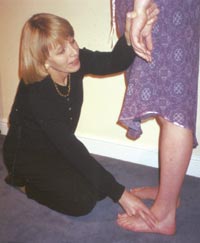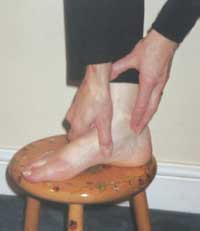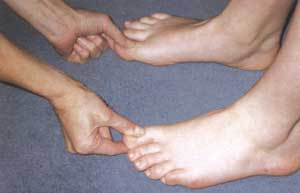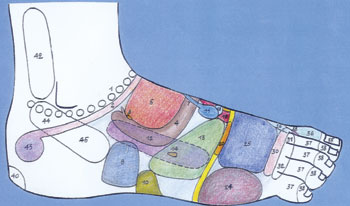Positive Health Online
Your Country

Vertical Reflexology
listed in reflexology, originally published in issue 63 - April 2001
On first inspection this technique appears to negate the basic tenets of reflexology, as the main collection of plantar reflexes is no longer accessible to the therapist when the client is standing. However, research indicates not only that all reflexes can be accessed through the dorsum but that the body is more responsive to a healing and energetic stimulation when treated briefly in a standing position. It has been suggested that VRT can reach deeper, possibly new, reflexes, allowing homeostasis or balance to be achieved in a shorter time.
Over the past six years I have developed this simple but profound form of reflexology, which is used with, and complements, conventional treatments but has also achieved results for numerous practitioners in less than five minutes. Most VRT techniques can also be successfully used in reclining, conventional reflexology treatments where the results are more gentle and subtle.
I discovered the benefits of vertical reflexology when working with chronically sick residents in my weekly clinic at the St Monica Trust nursing home, Bristol, which houses 200 elderly people. In a small medically-approved VRT trial, over 60% of the chronically ill residents improved within seven weeks and their progress was maintained.

Three VRT reflexes worked simultaneously
Since 1998, over 1,800 qualified reflexologists have attended VRT courses in the UK and Europe, and feedback shows there is wide application for shortened VRT/conventional reflexology treatments both in the workplace as well as hospices, sports teams and elsewhere. Effective self-help VRT on the hands and feet is one of the key elements, both preventative and curative, for reflexologists, their patients and family and friends.
The first VRT treatments were directed towards orthopaedic problems only, and these conditions usually have the quickest response to VRT. But, within months of using this technique, I became aware that all conditions could benefit and I subsequently developed other techniques that include synergistic reflexology (SR), where the hand and foot are worked simultaneously to increase the stimulation of the reflexes. Further developments include working three reflexes at once in various combinations on the feet and hands. These techniques, incorporating the new zonal trigger reflexes situated on the ankles, are particularly relevant for longstanding and intransigent problems. Later developments include precise nail-working where the toe and finger nails are worked in conjunction with the new set of dorsal reflexes.

Self-help VRT
The absolute rule with VRT is not to overwork the reflexes, and a maximum of five minutes standing is ample to achieve good results. Sometimes immediate improvement is observed with only three minutes of VRT at the beginning and/or end of a conventional reflexology treatment. The experienced reflexologist, when using VRT, will be immediately aware of a different 'feel' to the familiar reflex points and will soon learn to interpret and clear areas of congestion, often with greater clarity and speed than before. The client will also observe that the feet feel much more tender when worked in a weight-bearing position, and the therapist should be aware of this factor and decrease the pressure accordingly. Weekly treatments produce good results and a maximum of two sessions per week, in chronic cases, is recommended as the client's body needs time to adjust. Acute cases respond well to daily treatments, where possible, and the extremely responsive weight-bearing self-help on the hands and feet can be used several times daily on demand.
Background to the Discovery of VRT
All reflexologists are aware of the difficulty of treating disabled people in wheelchairs or who wear callipers. Often it is impossible to work the reflexes on the sole of the foot for long because the client's leg is at a painful angle. Out of sheer necessity I began to work the top of the feet as they rested on the wheelchair supports and gradually became aware that wheelchair-bound clients responded well to this form of reflexology, especially orthopaedic cases. I often used to ask them to press downwards with their feet as I could then penetrate deeper into the reflexes. I began mapping out new or deeper reflexes on the feet but the concept of VRT was only formalized after the following incident:
A 74- year-old woman was injured in an accident and had very limited mobility as she was too frail to undergo a hip replacement operation due to chronic angina. She told me her right leg and hip were in great pain, so I knelt down and worked the hip, leg, spine and pelvic reflexes for no more than 90 seconds, while she remained standing. Ten minutes later, after I had left, she had an acute pain in her right hip followed by soreness and tingling which lasted approximately 30 minutes. Her hip was then much less painful and by the next day she could move her foot and leg higher than she had done for months. The next day I visited her to find her holding on to her Zimmer frame and rather recklessly lifting and swinging her leg to demonstrate her new-found mobility! I realized at once that the missing link to my research was that the feet had to be fully weight-bearing for the reflexes to become so receptive. Within ten weeks she had regained full mobility. Six years later she is still mobile and flexible despite her consultant's prognosis that she would be wheelchair-bound in 18 months.
Following the woman's recovery, which was monitored by the medical staff at the nursing home, I used reflexology on all my clients' standing feet with great success. I immediately began teaching these basic VRT techniques to colleagues and they achieved similar extraordinary results. In 1997, I conducted a small medically-approved and monitored trial on eight chronically sick geriatric residents in the nursing home. Although multiple pathologies were present, the criterion was to measure decrease in pain and increase in mobility regardless of the medical history. Reflexologists do not diagnose specific illness but can treat specific conditions in a holistic manner, enabling the body to achieve self-healing in a shorter space of time. Over a seven-week period comprising one fifteen-minute VRT/conventional reflexology treatment per week, over 60% of the participants were found to have more mobility and a decrease in pain. Two months later, their improved status was constant. In two trial cases the results were exceptional.
Trial Results
A 61-year-old woman was submitted because of her knee problems but also had an excruciating deep pain in her left groin that would cause her to cry out when she moved. At the end of the trial she was virtually pain free after many months of discomfort in her groin, although her knee failed to respond. Another person began walking around the room for the first time in a year and experienced a cessation in 'an overall soreness of the skin and depression'. Most reported better sleep and less pain and one reported 'no temper explosions for seven weeks', which, as they occurred on a weekly basis, was apparently something of a record! By the time the trial was concluded there was already no doubt among myself, the medical staff and my colleagues that VRT was not only a powerful new form of reflexology for orthopaedic problems but that it was an holistic technique that helped stimulate the entire body mechanism.
Hypothesis – How Vertical Reflex Therapy Works
It rapidly became obvious to me that, by treating the tops of the feet, the zones and therefore the reflexes were being accessed in a three-dimensional mode. Clients with a variety of non-orthopaedic ailments were responding positively, although, in the brief five-minute treatments, the conventional reflexes such as the stomach, liver or colon were not being worked directly. Instead, the same plantar reflexes were being accessed vertically from the dorsum.
Neutrality
I propose that VRT puts the body into a neutral state where the long-term legacy of strain, tension, degeneration or scar tissue in its systems is bypassed to allow direct access to the original problem. For example, this would explain some of the recorded VRT case studies where the body has made an almost instantaneous response, such as when a stiff arm or leg becomes mobile after a long period of inactivity. It is rewarding if a shoulder frees up in a VRT workshop, as the reflexologists are made aware of the power of the therapy as well as the speed in which the body can respond. A word of caution is appropriate as therapists and clients are often eager to show off their new-found mobility and keep stretching or moving their arm, leg or neck to show the increased range of movement. Do not over-exercise initially, as the muscles, ligaments, vertebrae and blood supply, etc., to the area need time and consideration so they can gently continue the healing response.
The Standing Body is in a Position of Vitality
My theory is that the upright body appears to be in a position of increased vitality when it is weight bearing, as the muscles are taut – allowing the reflexes to become much more responsive. There is a positive pressure on the skeletal bones, and the heart is pumping oxygenated blood to the organs, which, in a standing position, will be less impacted by bad posture. In a more esoteric sense, it has been suggested that the feet are also earthed to the ground in a way that appears to give a more energetic response.
The Zones – A Three-dimensional Model
VRT appears to activate the ten zones in an unprecedented way. I believe that the zones themselves can become congested and VRT can recharge and clear these invisible energy lines thus accelerating the healing processes. The reflexology model states that there are invisible energetic lines between the reflexes on the feet and hands and every part of the body, and that stimulation of a certain reflex sends an energetic impulse to a particular organ or gland. With VRT there appears to be an unprecedented surge of energy and, instead of the stimulation of individual reflexes, the entire zone is more receptive.
The newly discovered zonal triggers (ZTs) are deep ankle reflexes that play an important role in activating the zones extremely quickly so that the body is more receptive to healing. There seems to be a faster and more direct line of communication between the reflexes and the parts of the body when the feet are weight bearing. Not only does the stimulation become more powerful in reaching an affected part, but congestion in another part of the body can be quickly overridden. Many people report a rush of warmth or energy as they experience VRT, followed by mild tingling sensations as the body makes numerous adjustments to achieve homeostasis or balance in a shorter space of time.
|
|
|
|
1. Zonal Triggers |
26. Trachea/ oesophagus/ bronchial tubes |
Figure 1: Three-dimensional lateral view of right foot and layers of VRT Dorsal Reflexes
The cross-section of the foot shown in Figure 1 illustrates the various layers of reflexes that can be easily accessed when the feet are weight bearing. By pressing reflexes on the dorsum one can access four layers of reflexes at once:
* the traditional dorsal reflexes and new VRT reflexes and zonal triggers;
* the layer of reflexes connected with the emotional system;
* the body's catalogue of past injuries and degeneration; and
* the traditional plantar reflexes.
Advances and Variations in VRT
Over the years I have developed many optional advanced techniques such as linking neural pathway reflexes to two other reflexes on the feet. The diaphragm rocking (DR) techniques of the reclining foot are deeply relaxing and profound movements that I originally developed for insomnia to help re-set the body clock. I felt that it could probably help balance and correct the body when coupled with VRT and this has proved to be the case. This gentle specific technique appears to prioritize the body's needs and pumps energy to the area most needed. For example, a reflexologist may treat the lower lumbar reflexes as lower backache has been presented by the client. However, when the rocking technique is introduced half-way through a treatment, the person treated may report that they suddenly have a feeling of warmth in the neck or upper thoracic area which would indicate that the original cause of the problem was not in the lower back. DR has a specific application in the treatment of ME, stress-related problems and is particularly helpful in the treatment of alcohol and drug abuse especially at the post-detox stage.
'Knuckle dusting' is another newer technique where the fist is gently twisted over all the reflexes on the top of the foot, and it is one of the most effective techniques. It is only applied for about 15 seconds per foot and appears to help conditions as diverse as asthma and depression.
'VRT nail-working' is a new and effective technique worked precisely but lightly, nail to nail, as if mapping out a tiny grid system. It appears to tap into the inherent pressure on all the reflexes situated under the nails, especially the thumb and big toe nail which cover the brain and part of the central nervous system reflexes.

The VRT 'Pituitary Pinch'
Reflexology in the Workplace
Reflexology is increasingly becoming integrated into the workplace with therapists holding clinics in many of the high street stores and at commercial firms such as insurance companies. Some hospitals and hospices are realizing the benefits of reflexology for their staff as well as patients. VRT has a particular part to play in this field as the accelerated healing techniques mean that three people can be treated in an hour with 'Complete VRT' instead of one or two. Complete VRT is a fully comprehensive reflexology treatment of 20 minutes' duration, which incorporates a few minutes of VRT techniques either side of conventional reflexology and relaxation techniques. I still recommend that a full 45-60 minutes of reflexology/VRT is the preferred option, as the client is able to experience a longer period of rest and treatment, as well as a precise and professional conventional treatment. The accelerated response of VRT offers therapists an extremely useful tool to treat more people in a shorter space of time and is especially suitable for the elderly, chronically ill and young children. There is also a wide application for the use of VRT in the fields of sport, music, theatre and dance, and commerce, as well as in professions such as the police.
Case Studies
Case Study 1: Orthopaedic
Nicky was an extremely agile fifteen-year-old schoolgirl who excelled in acrobatics. A week before I saw her she had landed awkwardly after sliding down a rope and had hurt her back. The lower lumbar area was extremely tender and she experienced a sharp pain whenever she leaned backwards. I briefly worked her feet with the five-minute Basic VRT and found the spinal reflexes (around L1 and L2) extremely tender on both feet. I worked synergistically on the hip reflexes on her hands and feet and then found the zonal trigger for the lumbar area on her ankle. I asked her to sit on a chair, placed both feet on my lap and gave her a couple of minutes of gentle diaphragm rocking on each foot. Half way through treating the second foot she experienced a sharp click in her upper thoracic spine, between her shoulder blades.
When she stood up, a minute later, her back felt free and she could bend in all directions with no further pain. This example illustrates the important role that diaphragm rocking can play in every treatment, whether it is part of VRT or conventional reflexology. The specialized rocking prioritizes and pumps energy to the area the body needs it most. In other words, I treated both feet with VRT and concentrated on Nicky's painful lower spinal reflexes. But the diaphragm rocking allowed the body to select exactly which part of the spine needed correcting and obviously the upper thoracic area had become misaligned as it tried to compensate for the lower back problem. Once the body had made the correction, she instantly in this case became pain free. Six weeks later her back was still symptom-free and she reported that she had felt 'even more mobile' since the VRT treatment. She explained that she had slightly hurt her back the previous summer and afterwards was unable to stretch quite so far. She had forgotten all about the incident until she realized that she had regained that lost range of mobility after VRT.
Case Study 2: Lymphatic
Lily was a lady of eighty-two who was becoming increasingly inactive due to arthritic joints and 'general weariness', as she put it. She came to me for reflexology and VRT as a last resort and was agreeably surprised to find that her aches and pains began to subside as she had weekly, then monthly, treatments. Her blood pressure naturally lowered, as it often does with conventional reflexology, to a more normal level and her GP was able to reduce her medication. Within a few months she could raise her arm to brush her hair again properly and had so much energy she started gardening vigorously and even mended a fence! She then presented with a severe lymphatic problem, especially in the left foot, and I gave her VRT on arrival and worked the swollen foot very lightly. By the end of her treatment the swelling in both feet had subsided and, more surprisingly remained so, and the puffiness did not return until about a month later when she was due for her next treatment. In my conventional reflexology treatments I had observed that the swelling usually returned within a week or so. She knows she can keep the problem at bay if she comes every four or five weeks. Lymphatic problems have always been receptive to reflexology and are some of the quickest to respond to VRT.
Self-help and Workshop Feedback
A recent letter from a reader of a national broadsheet newspaper after following the brief self-help instructions in an article about VRT commented:
"I followed the Do-it-yourself VRT.... The result is that I now get a decent night's sleep with no backache."
A workshop participant reported instantaneous healing of a swelling:
"I came to a [VRT] workshop in May. I had a bad back (a lump in the sacro-iliac area), which had been causing me trouble for some months. You demonstrated the treatment, the lump vanished together with the pain, and has not returned. So thank you for that. I did feel ill for the rest of the afternoon though – I think the change was so sudden. All I wanted to do was lie down." SA, Devon
Conclusion
The simplicity of VRT, coupled with advanced techniques for 'fine-tuning' the body, make it a very accessible and effective new skill for reflexologists. The 'Basic VRT Revitalizer' treatment is suitable for self-treatment for family and friends as well as other disciplines. Osteopath, and former reflexologist, Sarah Bunting, DO, states, "I sometimes use VRT for a few minutes at the end of my osteopathic treatments to relax the patient and consolidate my work, and I always get positive results."
One of the reasons VRT has become well integrated into reflexology practice in the UK and Europe is that it is simple to learn and apply and the practitioner kneels for only a few minutes. The use of knuckles and advanced reflexology training (ART) techniques, plus the different hand and body positions, enable the reflexologist to experience more flexibility of movement and less risk of repetitive strain injury. Orthopaedic cases, including frozen shoulders and whiplash, appear to respond the quickest, and I would encourage therapists to experiment gently with VRT techniques on orthopaedic conditions first as the results are usually very quick and positive for both practitioner and client. Reflexology is a profound and non-invasive therapy and VRT is simply a unique and powerful skill to add to a therapist's repertoire.
Further Information
For more information on VRT, practitioner courses or the nearest available VRT practitioner send an sae to: Booth VRT, Suite 205, 60 Westbury Hill, Bristol, BS9 3UJ; e-mail: contact@boothvrt.com, website: www.boothvrt.com
For details of ART training courses, please contact Anthony Porter (director), ART, 28 Hollyfield Avenue, London N11 3BY; Tel: 0208 368 0865, website: www.artreflex.com
Bibliography
Booth Lynne. Vertical Reflexology. Piatkus. 2000.
Comments:
-
No Article Comments available
